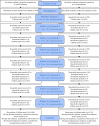Evaluation of an on-site sanitation intervention against childhood diarrhea and acute respiratory infection 1 to 3.5 years after implementation: Extended follow-up of a cluster-randomized controlled trial in rural Bangladesh
- PMID: 35939520
- PMCID: PMC9394830
- DOI: 10.1371/journal.pmed.1004041
Evaluation of an on-site sanitation intervention against childhood diarrhea and acute respiratory infection 1 to 3.5 years after implementation: Extended follow-up of a cluster-randomized controlled trial in rural Bangladesh
Abstract
Background: Diarrhea and acute respiratory infection (ARI) are leading causes of death in children. The WASH Benefits Bangladesh trial implemented a multicomponent sanitation intervention that led to a 39% reduction in the prevalence of diarrhea among children and a 25% reduction for ARI, measured 1 to 2 years after intervention implementation. We measured longer-term intervention effects on these outcomes between 1 to 3.5 years after intervention implementation, including periods with differing intensity of behavioral promotion.
Methods and findings: WASH Benefits Bangladesh was a cluster-randomized controlled trial of water, sanitation, hygiene, and nutrition interventions (NCT01590095). The sanitation intervention included provision of or upgrades to improved latrines, sani-scoops for feces removal, children's potties, and in-person behavioral promotion. Promotion was intensive up to 2 years after intervention initiation, decreased in intensity between years 2 to 3, and stopped after 3 years. Access to and reported use of latrines was high in both arms, and latrine quality was significantly improved by the intervention, while use of child feces management tools was low. We enrolled a random subset of households from the sanitation and control arms into a longitudinal substudy, which measured child health with quarterly visits between 1 to 3.5 years after intervention implementation. The study period therefore included approximately 1 year of high-intensity promotion, 1 year of low-intensity promotion, and 6 months with no promotion. We assessed intervention effects on diarrhea and ARI prevalence among children <5 years through intention-to-treat analysis using generalized linear models with robust standard errors. Masking was not possible during data collection, but data analysis was masked. We enrolled 720 households (360 per arm) from the parent trial and made 9,800 child observations between June 2014 and December 2016. Over the entire study period, diarrheal prevalence was lower among children in the sanitation arm (11.9%) compared to the control arm (14.5%) (prevalence ratio [PR] = 0.81, 95% CI 0.66, 1.00, p = 0.05; prevalence difference [PD] = -0.027, 95% CI -0.053, 0, p = 0.05). ARI prevalence did not differ between sanitation (21.3%) and control (22.7%) arms (PR = 0.93, 95% CI 0.82, 1.05, p = 0.23; PD = -0.016, 95% CI -0.043, 0.010, p = 0.23). There were no significant differences in intervention effects between periods with high-intensity versus low-intensity/no promotion. Study limitations include use of caregiver-reported symptoms to define health outcomes and limited data collected after promotion ceased.
Conclusions: The observed effect of the WASH Benefits Bangladesh sanitation intervention on diarrhea in children appeared to be sustained for at least 3.5 years after implementation, including 1.5 years after heavy promotion ceased. Existing latrine access was high in the study setting, suggesting that improving on-site latrine quality can deliver health benefits when latrine use practices are in place. Further work is needed to understand how latrine adoption can be achieved and sustained in settings with low existing access and how sanitation programs can adopt transformative approaches of excreta management, including safe disposal of child and animal feces, to generate a hygienic home environment.
Trial registration: ClinicalTrials.gov; NCT01590095; https://clinicaltrials.gov/ct2/show/NCT01590095.
Conflict of interest statement
The authors have declared that no competing interests exist.
Figures



References
Publication types
MeSH terms
Associated data
Grants and funding
LinkOut - more resources
Full Text Sources
Medical
Research Materials

